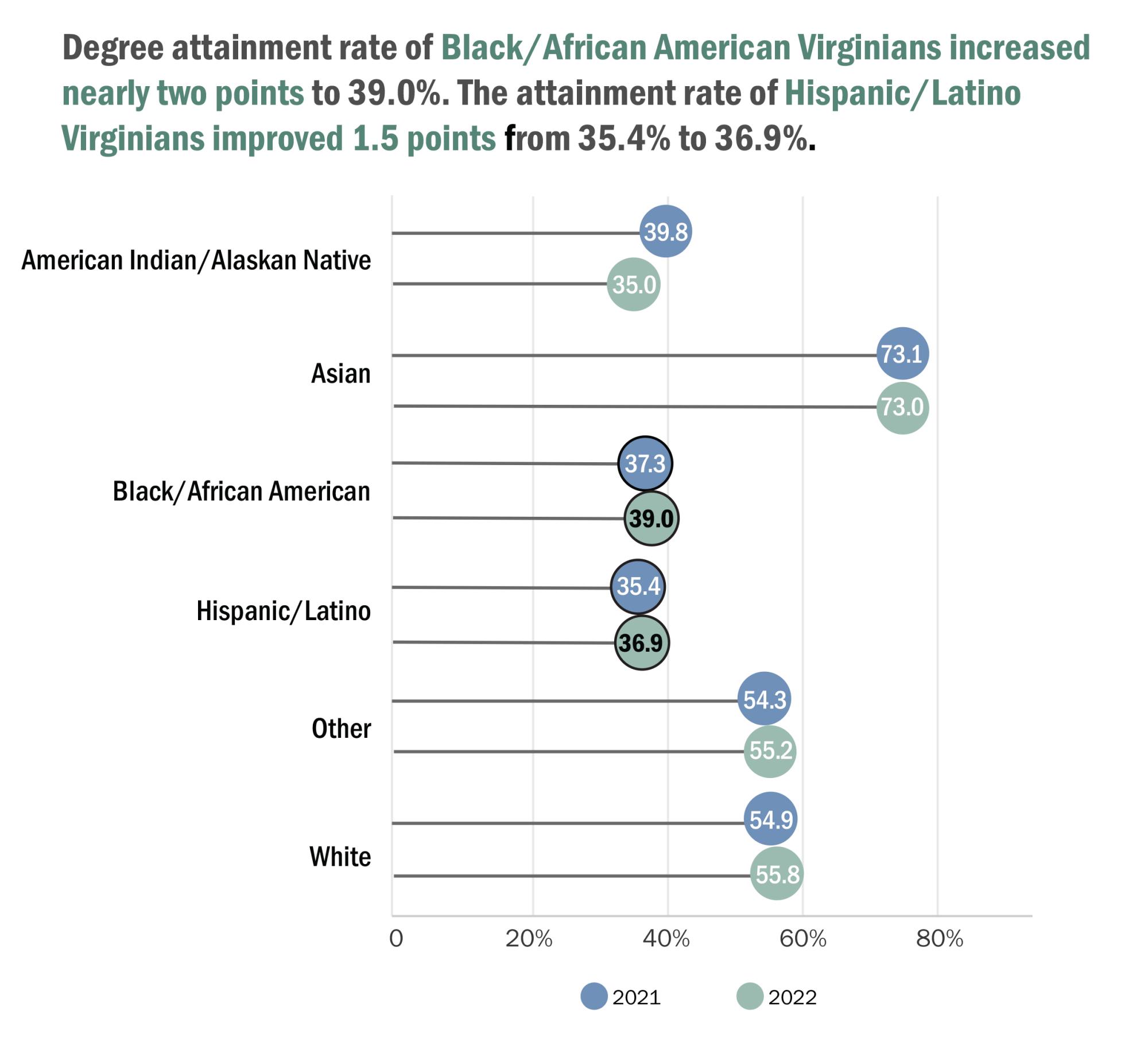The rate of working-age Virginians who possess a postsecondary credential or degree remained flat in 2022, according to new estimates released by the Lumina Foundation. However, the Commonwealth increased its rank from 7th to 6th in the nation and saw increases in attainment for Black/African American Virginians and Hispanic/Latino Virginians.
Postsecondary attainment comes with economic and social benefits: College graduates earn higher wages, are more likely to have health insurance, pay taxes, vote and volunteer, and are less likely to rely on public assistance. Pathways to Opportunity, Virginia's strategic plan for higher education, sets a target of achieving the 70% attainment rate for working aged Virginians by 2030.
For 2022 (the most recent available data), Lumina estimated that 59.0% of Virginians aged 25-64 years-old had earned either a workforce certificate or certification or an associate degree or above. This figure is a slight decline from 2021’s estimate of 59.3%. The estimates rely on the American Community Survey and are subject to sampling error. Due to a decline in the attainment rate of Connecticut, Virginia improved its rank to 6th despite not making any gains in the rate.
The disaggregated estimates by race and ethnicity and by geography are available only for the degree attainment rate (i.e., associate degree and above, and not counting the workforce credentials or certificates). This degree attainment rate of Black/African American Virginians increased nearly two points to 39.0%. The attainment rate of Hispanic/Latino Virginians improved 1.5 points from 35.4% to 36.9%. Pathways to Opportunity also lays out an objective of closing attainment gaps for different groups.

Note: This rate does not include workforce credentials and certificates.
Source: Lumina Foundation
In terms of geography, Arlington, Falls Church and Lexington remain in the top three localities for degree attainment. Covington city, Buckingham and Lunenburg have the lowest attainment rates.
A state’s attainment rate is impacted not only by producing degrees and credentials, but also by whether those individuals remain in the state or move out. Policymakers are rightly concerned whether more people are moving out of the state than moving in. Determining whether more college-educated Virginians are moving out than in is more difficult to answer, however. According to the U.S. Census Bureau, people move for housing, family and employment, therefore improvements in net migration could require difficult policy efforts outside of higher education policy.
A SCHEV report also found that 74% of Virginia public colleges’ and universities’ in-state graduates were living in the state 10 years post-completion. But, only 20% of out-of-state graduates stayed in Virginia. Clearly, opportunity exists for progress on retention.
The Takeaway
Numerous strategies exist to increase Virginia’s postsecondary attainment rate, through either increasing production of degrees and certificates or retaining individuals with those credentials. SCHEV’s budget and policy recommendations for the 2024-26 focus on increasing operational support to help institutions moderate tuition and provide more financial aid in order to improve rates of student success.
Regarding workforce credentials specifically, the New Economy Workforce Credential Grant subsidizes training aligned with fields that are in high demand by Virginia employers. The Virginia Talent + Opportunity Partnership (V-TOP) aims to improve work-based learning opportunities, which may also incentivize graduates to stay in Virginia after graduation. SCHEV will continue to track Virginia’s progress toward our 70% attainment-rate target as the year 2030 approaches.
Welcome to Insights, SCHEV's platform to interpret and communicate data and policy with the overall goal of informing policy-making, engaging institutions and drawing attention to these resources. Centered around SCHEV's nationally leading data collection, each Insight will visualize complex ideas and help inform funding and policy decisions.
